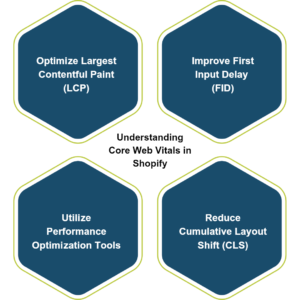Having a fast and user-friendly website is crucial for online success. Google’s Core Web Vitals is a set of metrics that measure the user experience on websites. For Shopify store owners, optimizing Core Web Vitals is essential to improve website performance, search engine rankings, and ultimately, customer satisfaction. In this guide, we will explore effective strategies to optimize Core Web Vitals for your Shopify store and enhance its overall performance.
Understanding Core Web Vitals:

Core Web Vitals consist of three key metrics: Largest Contentful Paint (LCP), First Input Delay (FID), and Cumulative Layout Shift (CLS). LCP measures the time it takes for the largest content element to become visible, FID measures the delay between a user’s first interaction and the browser’s response, and CLS quantifies the unexpected layout shifts during page loading. Optimizing these metrics will ensure a seamless user experience and improved website performance.
Optimize Largest Contentful Paint (LCP):
LCP is directly related to the loading speed of your website. To optimize LCP for your Shopify store:
- Optimize and compress images: Resize images to the appropriate dimensions and compress them without compromising quality.
- Utilize lazy loading: Implement lazy loading techniques to load images and content as users scroll, reducing initial load times.
- Leverage a content delivery network (CDN): Use a CDN to distribute your content across multiple servers globally, reducing latency and improving loading times.
Improve First Input Delay (FID):
FID measures the responsiveness of your website. To enhance FID for your Shopify store:
- Minimize JavaScript execution time: Optimize and minify JavaScript files to reduce their size and improve execution speed.
- Use browser caching: Enable browser caching to store static resources, allowing subsequent page visits to load faster.
- Eliminate render-blocking resources: Identify and eliminate CSS and JavaScript that block rendering, optimizing the loading sequence of your website.
Reduce Cumulative Layout Shift (CLS):
CLS measures the stability of your website’s visual elements during loading. To minimize CLS for your Shopify store:
- Set dimensions for media elements: Specify width and height attributes for images and videos to prevent layout shifts.
- Reserve space for ads and embedded content: Allocate sufficient space for dynamic elements to avoid sudden shifts during loading.
- Load fonts properly: Use the “font-display” property to control how web fonts are loaded and prevent layout shifts caused by font loading.
Utilize Performance Optimization Tools:
Shopify provides various performance optimization tools and apps to help improve Core Web Vitals:
- Use Shopify’s built-in optimization features: Enable features like lazy loading, responsive images, and deferred scripts.
- Install optimization apps: Explore Shopify’s app store to find tools that can further enhance your website’s performance and user experience.
- Regularly monitor performance: Continuously monitor your website’s performance using tools like Google PageSpeed Insights or Lighthouse to identify areas for improvement.
In Short, Optimizing Core Web Vitals is crucial for Shopify store owners to deliver a fast and seamless user experience. By implementing the strategies outlined in this guide, you can improve your website’s loading speed, responsiveness, and visual stability. Remember to regularly monitor your website’s performance and adapt as needed to keep up with evolving best practices. With a well-optimized Shopify store, you’ll not only boost user satisfaction but also increase your chances of higher search engine rankings and improved conversion rates.
Check out our Previous Blogs- How To Optimize Core Web Vitals For YouTube Videos







